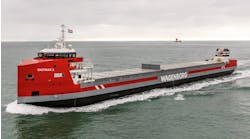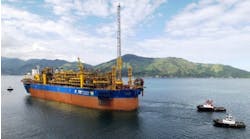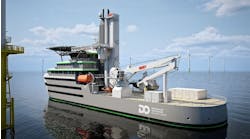NAVIGATION & POSITIONING: Battling vessel GPS positioning scintillation in tropical regions
Despite the appearance of new high-quality differential GPS services, many drilling rig and floating production, storage, and offloading (FPSO) vessel operators remain uneasy about relying upon them for positioning their vessels in equatorial regions. High levels of solar and ionospheric interference have made some systems vulnerable to outages or significant error, and operators increasingly consider the risk too great to rely upon them for primary positioning.
Sunspot activity (scintillation) is responsible for much of this problem. The problem reached a peak last year, but the interference is nevertheless expected to persist for the foreseeable future. UK-based Sonardyne International has used long baseline and ultra-short baseline (LUSBL) acoustic positioning systems as the primary position reference system on dynamically positioned (DP) vessels. To do this, the LUSBL system has to provide the DP system with positioning as repeatable and stable as DGPS (differential GPS).
Tropical users
Scintillation is most acute in tropical regions, particularly offshore Brazil and West Africa. R&B Falcon is using a Sonardyne LUSBL as the primary positioning system on its FPSO, the Seillean. This was the first FPSO in the world to operate using only DP. The Sonardyne system has been able to provide the reliability and repeatability needed for the recently completed two years of continuous operation in 1,853 meters water depth, within the Roncador field off Brazil, during which time the Seillean averaged production of 20,000 b/d of oil. Linked to the vessel's Alstom DP thruster control, the system is enabling the ship to hold station above the well and remain unaffected by the interference of scintillation that can cause periodic unreliability for GPS-based systems.
The vessel's seabed array comprises eight switchbeam transponders, which provide directional signals for the surface positioning requirements and a switched wide beam for communi- cation with the other seabed transponders. Because precise positioning is even more necessary when working with production risers, the system also includes two acoustic riser angle beacons. These are fitted with inclinometers and provide the operators with real-time attitude measurements of the riser.
BOP stack position
For drilling vessels, greater positioning redundancy can be obtained by placing a navigation transceiver on the blowout preventer (BOP) stack. A benefit of the BOPNav system is that the range measurements sent in LBL mode from the vessel's transceiver to the other seabed transponders can be received by the BOPNav. This improves the stability and reliability of the signals as the transceiver is, in effect, located in the quieter environment of the BOP stack. The signals are then passed up an umbilical link to the system's navigation processor, which controls the transmission and decoding of acoustic data. As the transponder and BOP positions are known, an LBL position of the vessel can be calculated without the vessel directly receiving the replies.
The BOPNav system can also act as a responder, triggered by a signal sent from the navigation processor down the BOP riser's communications link. The BOPNav replies with a transmission that is received by the vessel's transceivers to give a USBL position fix. This effectively doubles the standard update rate because it eliminates the need for an acoustic signal to be sent from the vessel to the seabed.
The stability of the LUSBL system is largely due to the design of the through-hull transceiver. The company's USBL transceiver head has a listening area that extends in a hemisphere in all directions from the bottom of the vessel. The hemispherical beam shape is designed so it does not hear the ship's thruster noise coming from above. Sonardyne's experience has confirmed that it is better to not hear the noise in the first place, than pursue the alternative option of trying to eliminate the noise electronically.
In the past, operators wanting dependable acoustic system performance in deepwater or when operating noisy vessels have had the option of either fitting quieter thrusters or of deploying high power transponders on the seabed. Neither is entirely satisfactory as the expense of new thrusters may not be justified, and high power transponders require frequent recovery and battery changes.
In designing the surface unit, Sonardyne acknowledged a need to enhance the design of its standard head to further eliminate thruster noise. This resulted in a transceiver unit that listens downward in a cone extending +/-50 degrees from the vertical, so it does not hear the thrusters, yet, in deepwater it monitors a huge area of the seabed directly below. Within its operating cone, the transceiver achieves a far superior signal-to-noise ratio, which also means that on quiet vessels even fainter, longer range, signals from low power transponders can be received to provide DP vessel operators with confidence in the accuracy and dependability of their positioning.


